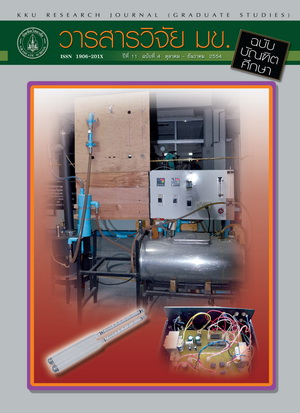แรงงานอพยพพม่าในจังหวัดอีสานนครของภาคอีสาน (Myanmese Migrant Workers in Nakorn Isan Province, the Northeast of Thailand)
Keywords:
Myanmese, Migrant workersAbstract
This research of Myanmese migrant workers in Nakorn Isan Province, the Northeast of Thailand. was performed to study the daily life of Myanmese migrant workers in Nakorn Isan Province both at their workplaces and outside. Qualitative Research Mothodology was used for this study. Study site was purposively selected at one factory in Isan Province the Northeast of Thailand. The study of 30 Myanmese migranrt workers shows that most of them that migrated to work in One Province Thailand are driven by the difficulties of their life in Myanmar. They are mostly from very poor families that have no money, no job, no electricity, not even the vehicle that can take them to the hospital when they are in need of medical care. Most migrations are done through a broker system. Boarder points that are most used are at the crossing bridges to Myanmar at Mae-Sai District of Chiangrai Province and at Mae-Sod District of Talk Province and by car.More than 75% of the Myanmese workers at the factory have work permits. 90% of them are general workers. Over 60% get an average wage per day of 181 bahts with daily expenditure of about 63 bahts in average. More than 70% cannot speak Thai and have a working period of less than 1 year. Most of the Myanmese workers live in the area of the factory. Therefore, major parts of their living are in the factory both during their working hours and after. During daily working hours, Myanmese workers were divided according to their abilities, skills and knowledge, whilst some additional training might be given by the factory. During the working hours, if the labors got sick, a clinic was provided. If the sickness was serious, some of the workers who could speak Thai would report to the factory administration so that they could be hospitalized and come back to resume work afterwards. The factory has a limited living area allocated to them. Workers from different nationalities are separated into groups of: single males, single females, and couples. It can possibly be that the factory needs to have measures to prevent and avoid problems which may arise such as: disputes, close intimate contact, getting pregnant during the working term prior to completion of their working agreement that will be followed by the termination of employment, as well as protection from contagious diseases. If any problems arise, they will then become the financial burden of the factory to bear the cost of caring and medical treatment that might be needed. These problems should be prevented more than to be solved as it will result in high cost per worker. After working hours, most Myanmese workers would remain in the area allocated to them by the factory and join common activities together such as sports, listening to the music, watching television, resting, etc. Some of them raised livestock and grew some vegetables for food. They prepared their own meals, bought the ingredients from the store in the factory area, as the cost for buying prepared food was very high for them compared to what they earned which was about 70-80 bahts per day. Their lives working in Thailand were better as most of them had enough food and could save some money to send back home whereas living in Myanmar they might be starving from having no money or job. It was found that living together in the workers barracks among Myanmese workers, there were no problems and no disputes. They could live happily together, help and talk to one another. However, they still need freedom to live. For example: to go out to buy food or necessary items, which they could not do because some (even a small number)of them still had problems with work permits and it raised their cost of living expenses higher than it should be. This resulted in lower amount of savings to send back to their family, and it was a cause for claiming an increase in pay afterwards.



